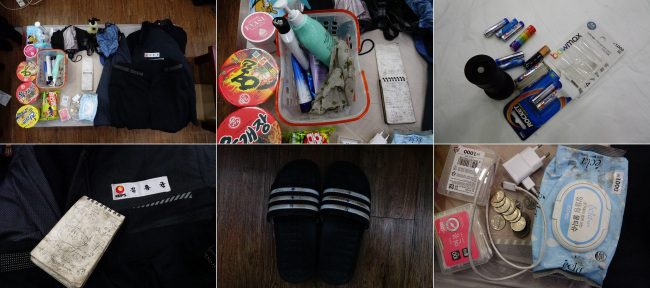Critics pointed out Sunday the mismanagement of safety by original contractors and dodgy safety inspections as major causes of an accident that killed a 24-year-old subcontract worker at a thermal power plant last week.
Kim Yong-kyun, who was a temporary worker at the Taean thermal power plant in South Chungcheong Province, died Tuesday after getting stuck between a conveyer belt and machinery while working his night shift alone. His death sparked public outrage as his harsh working conditions were revealed.

Late Kim Yong-kyun's parents speak at a press conference on Friday. (Yonhap)
On Sunday, chief of the National Human Rights Commission Choi Young-ae expressed regret over the accident and urged the government to revise the law to protect the rights of subcontract laborers from working in unsafe environments.
“I pray for the young laborer Kim Yong-kyun and send my condolences to the bereaved family,” Choi said in a statement. “The original contractors of businesses should no longer stand silent on the safety of their subcontract workers. The government and the National Assembly should also actively take actions to reinforce the law and systems on this issue.”
Kim was a temporary worker at the power plant. His shift started at 6:30 p.m. to remove coal that fell out from the plants, and to check for any abnormalities in bearings when the sound from the idler -- a part of the conveyer belt -- sounds peculiar, according to a special committee led by labor unions.
While his work should have been done by at least two people for safety reasons, Kim was working alone when, at around 1 a.m. on Tuesday, he became stuck between a conveyer belt and machinery. There was no one there to shut down the equipment.
While similar accidents have happened at the Taean thermal power plant in the past, it had been designated a “safe workplace” by the government. Korea Western Power, the company that operates the power plant, was given tax reduction benefits based on its safety record because accidents involving subcontract workers are not recorded against the original contractor.

(Yonhap)
Just this year Korea adopted an integrated system for industrial accidents occurring at both prime contractors and subcontractors to prevent the shifting of responsibility.
But the system has only been implemented for limited industries, including production, railroads and subways and those with more than 1,000 full-time workers. Other industries such as energy production, mining and shipping have been exempted.
Criticizing the “outsourcing of dangers,” the human rights commission chief called for an amendment to the Occupational Safety and Health Act to ban outsourcing dangerous work at infrastructure sites and to mandate that prime contractors take responsibility for accidents that occur at work sites.
“To cut down labor costs, society is outsourcing even the responsibility to prevent accidents and disasters to subcontractors -- ‘outsourcing the danger,’” Choi said.
“Under these circumstances, dispatched and subcontract workers are exposed to threats to their safety and life, in addition to their unstable employment.”
Meanwhile, Korea Western Power’s report to the National Assembly appears to have included a reduced number of onsite accidents.
During the parliamentary interpellation session last year, the energy company reported to Rep. Park Jeung of the Democratic Party of Korea that there were 44 industrial accidents and six deaths from 2008 to 2017.
However, the data allegedly excluded two accidents in which two subcontract workers were killed during the construction of an outer wall at a power production facility in September 2011, and another two who died from a fall in February 2016.
“It is an open secret that there are many industrial accidents that are not reported to the public. The authorities should conduct an overhaul of the public company,” said an official from a labor union said under the condition of anonymity.
Shoddy safety inspections have also come under fire, after a lawmaker revealed that the coal power plant passed an inspection two months before Kim’s accident.
According to Labor Ministry data received by Rep. Lee Yong-deuk of the Democratic Party, the coal transport facility passed a safety inspection performed from Oct. 11 to 12, concluding that the stabilizers and emergency shutdown services were properly in place. Korea Safety Technology Association, which conducted the inspection, had given a passing mark for the concerned conveyer belt, CV-09E.
“The victim could not take any actions (when the incident happened) because he was alone at dangerous work,” Rep. Lee said. “The education and safety check, which directly affect the workers, were also poorly done.”
By Jo He-rim (
herim@heraldcorp.com)


![[Exclusive] Korean military set to ban iPhones over 'security' concerns](http://res.heraldm.com/phpwas/restmb_idxmake.php?idx=645&simg=/content/image/2024/04/23/20240423050599_0.jpg&u=20240423183955)

![[Graphic News] 77% of young Koreans still financially dependent](http://res.heraldm.com/phpwas/restmb_idxmake.php?idx=645&simg=/content/image/2024/04/22/20240422050762_0.gif&u=)


